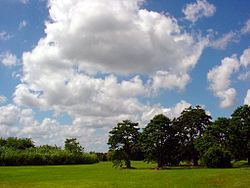Country United States County Miami-Dade Area code(s) 305, 786 Elevation 2.1 m | State Florida Time zone Eastern (EST) (UTC-5) FIPS code 12-36100 Local time Sunday 11:22 AM | |
 | ||
Weather 26°C, Wind E at 21 km/h, 63% Humidity | ||
Redland, often mistakenly called The Redlands by those in neighboring communities, is an unincorporated community in Miami-Dade County, Florida, United States, about 20 miles (32 km) southwest of Downtown Miami. Many farms, original clapboard homes of early settlers, u-pick'em fields and coral rock walls dot the landscape. It was named for pockets of red clay once common in the area, on top of a massive layer of oolite rock. Early residents intentionally created the singular community name "Redland" to make it easier to differentiate the town from Redlands, California. The entire area is nourished with pure water from the Biscayne Aquifer.
Contents
Map of Redland, FL 33031, USA
It has been a source of amazement to agriculturalists, botanists, and naturalists around the world, including John James Audubon and David Fairchild.
Many houses built in the area must be on a minimum of 5 acres (20,000 m2) of land, a law put into place to thwart development and preserve the area.
Peacocks live abundantly and freely within the many groves. Redland has also been designated a Wild Bird Sanctuary.
Geography
It is located at 25.528°N 80.49°W / 25.528; -80.49, its elevation 7 feet (2.1 m).
Climate
With its tropical climate, many tropical fruit crops are grown in Redland that cannot be grown commercially elsewhere in the United States but South Florida, such as mango, avocado, guava, passion fruit, lychee, jack fruit, canistel, sapodilla, longan, mamey sapote, black sapote ("chocolate pudding fruit"), miracle fruit, jaboticaba, cecropia ("snake fingers") and coffee beans, all of which can be sampled for free at the Fruit and Spice Park, a local attraction.
History
Redland originated in anticipation of Henry Flagler's railroad when pioneer homesteaders in the early 1900s developed a way of working the difficult soil, called scarifying or plow-breaking. This revolutionary method of agriculture allowed the land there to develop into the "winter greenery basket of America" and the "garden capital of the world". The center of town was located near Redland Road and Bauer Drive.
The area has many historic markers that tell the history of certain spots.
Education
Miami-Dade County Public Schools operates public schools.
